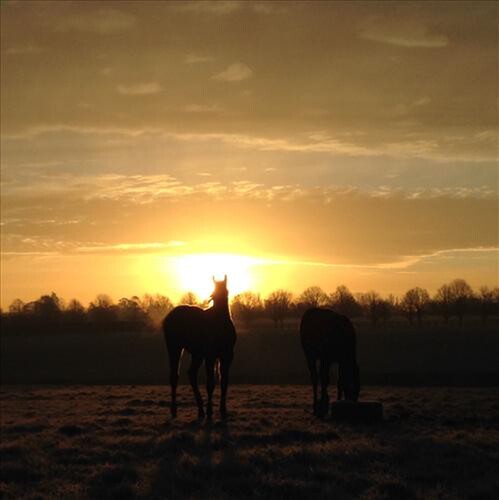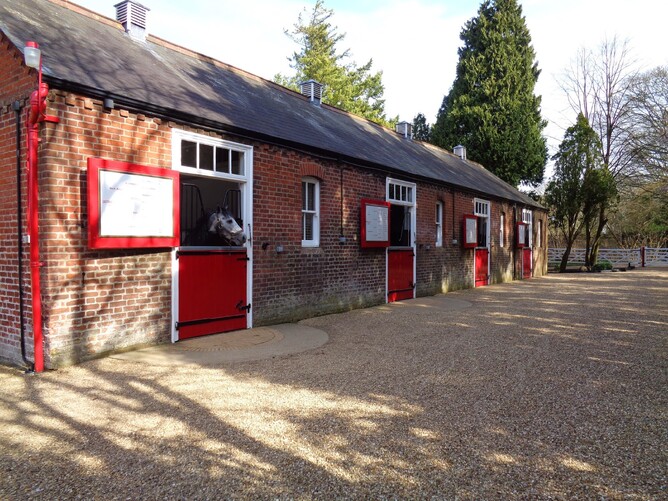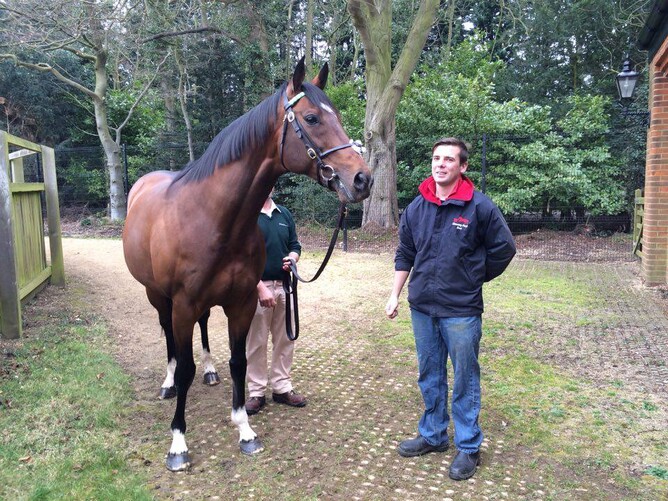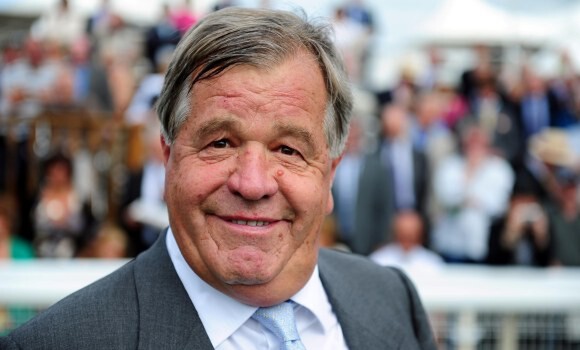First lesson in England – their leads don't have a clip. And they call them ropes. This discovery was the result of a somewhat confusing conversation with the stud groom during my first day in England. There have been many things that I have found different to the places I have worked in New Zealand and Australia, but before I get into them, I better introduce myself.
The best place to start is my name – Bevan Smith. I have grown up in the thoroughbred industry and my father, Chris Smith, worked at farms like Whakanui Stud and Trelawney Stud in New Zealand before shipping the whole family to Japan where we spent four and a half years.
Upon returning to New Zealand the old man turned to training, only having a few in the stable at a time. I am constantly trying to tell him how to train his horses and I take the credit if they win. If they don't win it is his fault, not mine.
I have had an interest in horses as long as I can remember and was annoying Dad at the stables even when I was knee-high to a grasshopper. I was always at my parents to put a dollar each way on the races for me at an early age.
My first experience in the racing industry outside of working as a slave for my father was at Waikato Stud during my high school years. I then went off to university at Massey University in Palmerston North, obtaining a Bachelor of Business Studies with a double major in Marketing and Sport Management.
Once I completed my degree I packed my bags and headed to Australia. Initially, it was to be for just six months for the yearling season but it turned into two and a half years of great experience.
I returned to New Zealand and took up a position in the Marketing Team at New Zealand Bloodstock. I gained valuable experience working with some of the best leaders in our industry. It was a great opportunity to use my degree and I got to work in the industry I am passionate about. While marketing was my primary function at NZB, I also took on a role with Gavelhouse, which has just launched a new website that I was a part of building, and I was given the opportunity to spend time with the bloodstock team, tuning my eye to the thoroughbred.
The best place to start is my name – Bevan Smith. I have grown up in the thoroughbred industry and my father, Chris Smith, worked at farms like Whakanui Stud and Trelawney Stud in New Zealand before shipping the whole family to Japan where we spent four and a half years.
Upon returning to New Zealand the old man turned to training, only having a few in the stable at a time. I am constantly trying to tell him how to train his horses and I take the credit if they win. If they don't win it is his fault, not mine.
I have had an interest in horses as long as I can remember and was annoying Dad at the stables even when I was knee-high to a grasshopper. I was always at my parents to put a dollar each way on the races for me at an early age.
My first experience in the racing industry outside of working as a slave for my father was at Waikato Stud during my high school years. I then went off to university at Massey University in Palmerston North, obtaining a Bachelor of Business Studies with a double major in Marketing and Sport Management.
Once I completed my degree I packed my bags and headed to Australia. Initially, it was to be for just six months for the yearling season but it turned into two and a half years of great experience.
I returned to New Zealand and took up a position in the Marketing Team at New Zealand Bloodstock. I gained valuable experience working with some of the best leaders in our industry. It was a great opportunity to use my degree and I got to work in the industry I am passionate about. While marketing was my primary function at NZB, I also took on a role with Gavelhouse, which has just launched a new website that I was a part of building, and I was given the opportunity to spend time with the bloodstock team, tuning my eye to the thoroughbred.
But that is enough about me, I could go on for hours but I'm sure you're all more interested in what I've been doing these past few weeks. I arrived in Newmarket in the middle of February expecting the cold, wet and miserable weather conditions that the UK is well-known for, but I was pleasantly surprised to be greeted with sunshine and mild temperatures.
Turns out I was lulled into a false sense of security! The weather quickly turned and the rain, wind and the freezing temperatures came, with snow even showing its face for a couple of days. While paddocks sprinkled with white looks pretty, working in it isn't much fun. There were some days that I thought very fondly of the nice, warm, heated office at Karaka and wondered what the hell was I doing! But not even the worst of weather could deter my enthusiasm for the experience I am gaining.
My home for the ten weeks that I am in the UK is Cheveley Park Stud, a place that has many claims to fame. Owned by David and Patricia Thomson, Cheveley Park Stud is the oldest stud in England and they are the largest English-based owner of racehorses in the country.
Cheveley Park Stud are standing seven stallions this season, headlined by Pivotal – the sire of 26 Group 1 winners. Making a kiwi connection, one of his Group 1 winners is Mareek who was part-owned by Sir Peter Vela when triumphant in a Group 1 sprint in France.
At Cheveley Park Stud I work with mares that are about to foal, mares that have foaled and mares that we are trying to get in foal. As with any stud there is plenty of mucking out to do but each day is different and I am seeing plenty that of things that I have not experienced before.
The team at Cheveley Park Stud have been very welcoming and made me feel part of the farm from day one. They have helped me experience all aspects of not only our Stud but some of the other famous farms around the area.
Turns out I was lulled into a false sense of security! The weather quickly turned and the rain, wind and the freezing temperatures came, with snow even showing its face for a couple of days. While paddocks sprinkled with white looks pretty, working in it isn't much fun. There were some days that I thought very fondly of the nice, warm, heated office at Karaka and wondered what the hell was I doing! But not even the worst of weather could deter my enthusiasm for the experience I am gaining.
My home for the ten weeks that I am in the UK is Cheveley Park Stud, a place that has many claims to fame. Owned by David and Patricia Thomson, Cheveley Park Stud is the oldest stud in England and they are the largest English-based owner of racehorses in the country.
Cheveley Park Stud are standing seven stallions this season, headlined by Pivotal – the sire of 26 Group 1 winners. Making a kiwi connection, one of his Group 1 winners is Mareek who was part-owned by Sir Peter Vela when triumphant in a Group 1 sprint in France.
At Cheveley Park Stud I work with mares that are about to foal, mares that have foaled and mares that we are trying to get in foal. As with any stud there is plenty of mucking out to do but each day is different and I am seeing plenty that of things that I have not experienced before.
The team at Cheveley Park Stud have been very welcoming and made me feel part of the farm from day one. They have helped me experience all aspects of not only our Stud but some of the other famous farms around the area.
I was lucky enough to take a mare to Juddmonte Farm to be covered by Frankel who we all know as the highest rated racehorse of all time and sire of the sale-topping yearling at Karaka 2016. Frankel was looking magnificent and was an absolute gentleman, letting me feed him his customary after cover mint.
Keeping great company, I also visited Darley (now Godolphin) which is located directly opposite Cheveley Park Stud. The sire roster there is pretty impressive to say the least. I was privileged to have my own private parade, which included Dubawi, one of the most preeminent sires in the world currently, and Golden Horn, last season's Cartier Horse of the Year. Needless to say I was in awe of the sire power stabled at what I have to say is probably the nicest farm I have ever seen.
I also went to Shadwell Stud, another impressive operation, where I got to see the brilliant sprinter Muhaarar. One of the most impressive features of Shadwell was their rehabilitation yard where many horses have successfully been restored to health and returned to the racetrack after suffering serious injuries. The effort Shadwell go to look after injured horses is heartening to see, they are given the very best of attention.
For a fanboy of thoroughbreds such as I, to get to see these giants of the racing world is why I wanted to come to this part of the world.
Keeping great company, I also visited Darley (now Godolphin) which is located directly opposite Cheveley Park Stud. The sire roster there is pretty impressive to say the least. I was privileged to have my own private parade, which included Dubawi, one of the most preeminent sires in the world currently, and Golden Horn, last season's Cartier Horse of the Year. Needless to say I was in awe of the sire power stabled at what I have to say is probably the nicest farm I have ever seen.
I also went to Shadwell Stud, another impressive operation, where I got to see the brilliant sprinter Muhaarar. One of the most impressive features of Shadwell was their rehabilitation yard where many horses have successfully been restored to health and returned to the racetrack after suffering serious injuries. The effort Shadwell go to look after injured horses is heartening to see, they are given the very best of attention.
For a fanboy of thoroughbreds such as I, to get to see these giants of the racing world is why I wanted to come to this part of the world.
Another day that had me in awe was visiting Sir Michael Stoute's racing stables. I was amazed to walk into the yard and see 40 horses milling around waiting to head out to the heath to work. All of these 40 horses had riders aboard. There was at least another dozen horses around the yard with riders aboard. That is at least 50 riders working for just one stable, an idea that was hard to fathom for someone used to going down to the Te Aroha track where there would be about 10 riders in total. I think even a track like Matamata would be lucky to have 50 riders for all horses, let alone working for one person.
Some of Sir Michael's horses were working strongly as they start to ramp up for the upcoming flat season. Another fanboy moment was when I realised Ryan Moore, the world champion jockey, was riding some of the horses we were watching. It was brilliant to see such an accomplished rider like Ryan Moore still doing the hard yards on the cold winter mornings.
Other extra circular activities that I have been able to do include spending a day at Rossdales Veterinary Clinic. I went into theatre and saw three surgeries before spending time with the diagnostic team. The size of the clinic was huge but that is not surprising considering the amount of horses based in Newmarket.
Everything in Newmarket is horse orientated. Cars give way to horses, there is a gym for industry related people, there is a racing museum and you don't need to ask anyone you meet what they do for a living, it is safe to assume they work with horses.
Getting back to some of the things that are different to back home include the foals having head collars on from an early age, mares are foaled down inside, all horses stay inside at night and they call soccer football (weirdos).
I feel like I have just touched the surface of what I have done so far but those are the most memorable bits. I am looking forward to many more great experiences and, with a month left in Newmarket, I am determined to make the most of what truly is the home of the thoroughbred.
Last but definitely not least, I would like to thank the Sunline Trust along with Shannon, Michael, Nicola and everyone who supports the New Zealand Thoroughbred Breeders' Association for the honour of being this year's recipient of the International Management Scholarship.
Until next time, you stay classy New Zealand!
Some of Sir Michael's horses were working strongly as they start to ramp up for the upcoming flat season. Another fanboy moment was when I realised Ryan Moore, the world champion jockey, was riding some of the horses we were watching. It was brilliant to see such an accomplished rider like Ryan Moore still doing the hard yards on the cold winter mornings.
Other extra circular activities that I have been able to do include spending a day at Rossdales Veterinary Clinic. I went into theatre and saw three surgeries before spending time with the diagnostic team. The size of the clinic was huge but that is not surprising considering the amount of horses based in Newmarket.
Everything in Newmarket is horse orientated. Cars give way to horses, there is a gym for industry related people, there is a racing museum and you don't need to ask anyone you meet what they do for a living, it is safe to assume they work with horses.
Getting back to some of the things that are different to back home include the foals having head collars on from an early age, mares are foaled down inside, all horses stay inside at night and they call soccer football (weirdos).
I feel like I have just touched the surface of what I have done so far but those are the most memorable bits. I am looking forward to many more great experiences and, with a month left in Newmarket, I am determined to make the most of what truly is the home of the thoroughbred.
Last but definitely not least, I would like to thank the Sunline Trust along with Shannon, Michael, Nicola and everyone who supports the New Zealand Thoroughbred Breeders' Association for the honour of being this year's recipient of the International Management Scholarship.
Until next time, you stay classy New Zealand!





